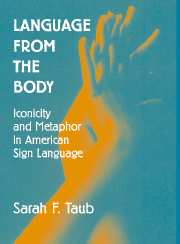Book contents
- Frontmatter
- Contents
- List of Figures
- Acknowledgments
- 1 A Glimpse of the Material
- 2 Motivation and Linguistic Theory
- 3 Iconicity Defined and Demonstrated
- 4 The Analogue-Building Model of Linguistic Iconicity
- 5 Survey of Iconicity in Signed and Spoken Languages
- 6 Metaphor in American Sign Language: The Double Mapping
- 7 Many Metaphors in a Single Sign
- 8 The Vertical Scale as Source Domain
- 9 Verb Agreement Paths in American Sign Language
- 10 Complex Superposition of Metaphors in an American Sign Language Poem
- 11 The Future of Signed-Language Research
- Appendix 1 Glossing Conventions
- Appendix 2 Translation of “The Treasure”
- References
- Index
10 - Complex Superposition of Metaphors in an American Sign Language Poem
Published online by Cambridge University Press: 16 October 2009
- Frontmatter
- Contents
- List of Figures
- Acknowledgments
- 1 A Glimpse of the Material
- 2 Motivation and Linguistic Theory
- 3 Iconicity Defined and Demonstrated
- 4 The Analogue-Building Model of Linguistic Iconicity
- 5 Survey of Iconicity in Signed and Spoken Languages
- 6 Metaphor in American Sign Language: The Double Mapping
- 7 Many Metaphors in a Single Sign
- 8 The Vertical Scale as Source Domain
- 9 Verb Agreement Paths in American Sign Language
- 10 Complex Superposition of Metaphors in an American Sign Language Poem
- 11 The Future of Signed-Language Research
- Appendix 1 Glossing Conventions
- Appendix 2 Translation of “The Treasure”
- References
- Index
Summary
METAPHOR AND POETRY
Poetic language draws on the same linguistic resources that we use in everyday language. Undoubtedly, most users of language strive for beauty in their linguistic output, and there are ample possibilities for such devices as wordplay, echoing/repetition, symmetrical structure, and joint creation of metaphor in normal conversation (cf. Ferrara 1994, Silverstein 1984). But the poet specifically focuses effort on fitting together linguistic structures to make a pleasing, coherent, and compelling whole. As we shall see, the linkage of metaphor and iconicity in signed languages provides the poet with rich resources for linguistic art.
A skilled poet can combine a number of usually distinct metaphors to form a coherent whole. In particular, the poet can create a scenario that contains the source domains of several metaphors – via the mappings, this scenario's concrete events evoke the corresponding abstract events. Using the terminology of Fauconnier and Turner (1996), we can describe the scenario as a blend of the metaphors.
In our chosen text, “The Treasure,” poet Ella Mae Lentz crafts a story that, on one level, describes a person digging down to discover buried treasure, and the reactions to her discovery – but on another level, describes the person's linguistic analysis of ASL, and the reactions to that discovery. The poem weaves together many different conventional metaphors into a compelling appeal to viewers to cherish and respect ASL.
- Type
- Chapter
- Information
- Language from the BodyIconicity and Metaphor in American Sign Language, pp. 196 - 221Publisher: Cambridge University PressPrint publication year: 2001



